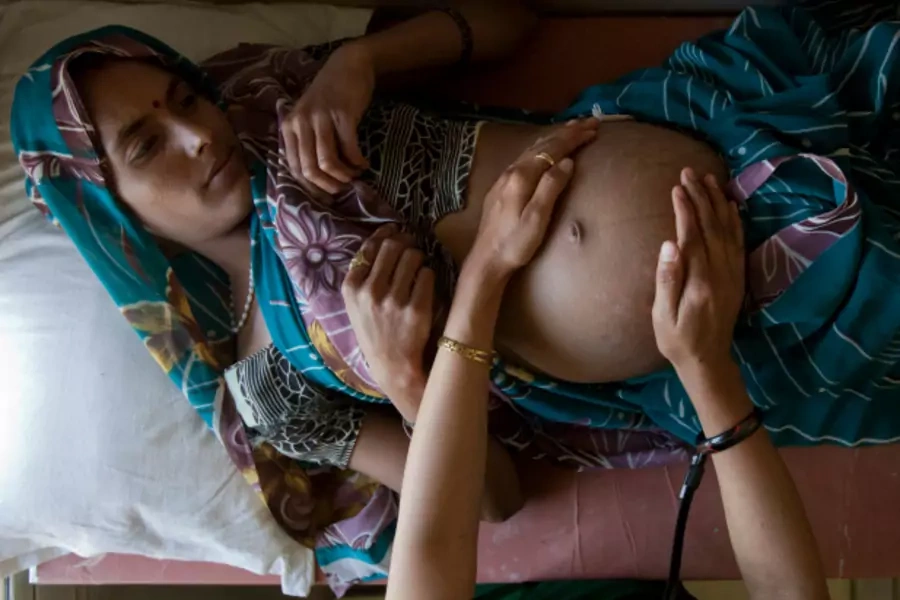Allen and Karp: Cell Phones - The Future of Rural Health Care in South Asia

More on:
This is a guest post by Becky Allen, the women and foreign policy intern at CFR, and Jenna Karp, the global health governance intern at CFR.
More people today have access to a mobile phone than a toothbrush: Of the six billion people in the world, 4.8 billion own a mobile phone, compared to the only 4.2 billion who own a toothbrush. In the developing world, mobile technology plays an increasing role with each coming year. According to a 2013 UN report, the number of mobile broadband connections was estimated to reach 2.1 billion worldwide by 2015, with some developing nations surpassing Western countries.
As the mobile tech industry proliferates, corporations and policymakers are turning their attention to cell phones as a new asset for advertising and information transfer in the developing world. The devices have already been used successfully for agriculture, education, and banking.
Now, mobile phone providers are working with two new partners—mothers and the health industry—to develop the field that has come to be known as mHealth (mobile health). Failure to address maternal and reproductive health challenges has dominated the global heath arena over the past decade. The statistics tell the story: 800 women die dailydue to preventable causes associated with pregnancy and childbirth, of which 99 percent occur in rural and impoverished areas. These figures leave the world far from achieving the Millennium Development Goal of reducing maternal mortality by three-quarters before 2015.
South Asia, in particular, where rural health systems fall far behind their urban counterparts, struggles to overcome high maternal death rates. Nearly one-third of all maternal deaths occur in South Asia, creating an unsafe and challenging environment for newborns. What makes the South Asia case unique is its proven commitment to improving maternal and reproductive health using this new mobile technology.
The Mobile Alliance for Maternal Action (MAMA) was founded by former U.S. Secretary of State Hillary Clinton on Mother’s Day 2011, with the goal of using mobile phones to improve maternal and reproductive health. MAMA successfully launched Aponjon in December 2012, a national mobile phone service in Bangladesh. Aponjon, meaning “trusted friend” in Bengali, began as a one-year pilot program to provide new and expectant mothers with vital information via mobile phones. It now delivers messages via SMS or voice two times per week, offering advice on topics including nutrition, medical checkups, and warning signs that something may be wrong. Aponjon even has a service specifically aimed at husbands and male family members to reinforce their support in advancing maternal health. Aponjon now serves nearly 600,000 mothers and families and has trained over 3,000 community agents to promote awareness for the initiative. The program is carried out in conjunction with a local social enterprise, Dnet, and the government of Bangladesh Ministry of Health and Family Welfare.
MAMA has recently turned its attention toward India. Through a cross-sector initiative, the organization plans to launch a partnership across six states to reach both local health care workers and mothers. The initiative will leverage India’s 900 million mobile subscribers, supplying critical health information to the nation with the world’s largest total number of maternal deaths. MAMA intends to inaugurate a pilot program in Mumbai later this year.
IntraHealth International, a U.S. government-funded nonprofit that promotes healthcare solutions in the developing world, is also using advanced software to address maternal health in India through the Manthan Project. In 2012, the Manthan Project began testing a mobile phone application called mSakhi, a tool designed to provide ongoing support to local health care workers. Meaning “mobile friend” in Hindi, mSakhi provides 65 health messages pertaining to prenatal care, postpartum mother and newborn care, immunization, family planning, and nutrition. The app employs a combination of text messages, audio clips, and illustrations to deliver its messages.
These developments in the field of mHealth are worth applause. However, the tech industry isn’t stopping here. New projects are already moving beyond messaging in the effort to advance maternal and reproductive health. Just this year, the 3G Mobile Ultrasound Patrol was implemented to avoid dangerous at-home births through early detection and treatment of major causes of maternal mortality. The technology is simple; portable ultrasound units are paired with 3G-enabled smartphones or “phablets” and remote 3G access to create low-cost imaging diagnostics. The images can uncover abnormal placenta challenges and some fetal complications. Medical professionals can use the devices in remote locations, shortening the time a patient must wait for a medical opinion from two weeks to 24 hours. The project’s trial study revealed that participating physicians reported an increase in the number of deliveries in health facilities, meaning a decrease in risky at-home births.
While the Ultrasound project has only been implemented in Morocco, it represents an exciting breakthrough in the mHealth world; one that will hopefully find its way to Asia, where the maternal health Millennium Development Goal continues to fall short. If governments, healthcare workers, and tech companies continue to develop and sharpen mHealth initiatives, the next generation of mothers—and consequently their children—will have a greater chance of prolonged life.
More on:
 Online Store
Online Store